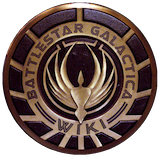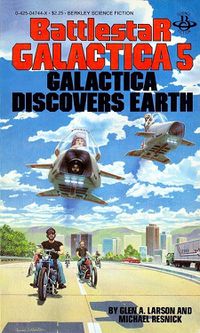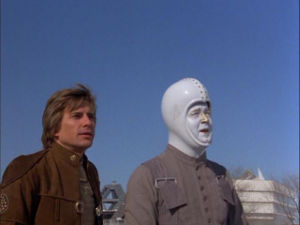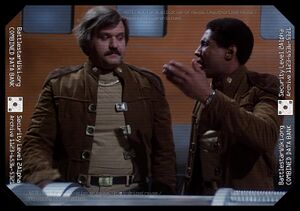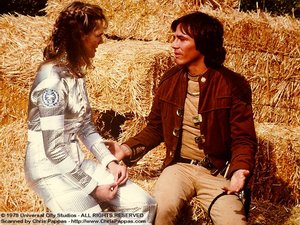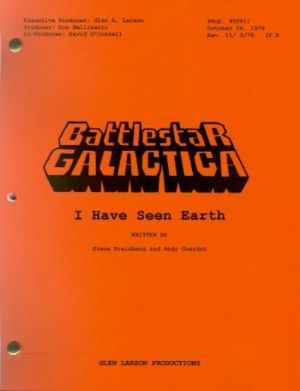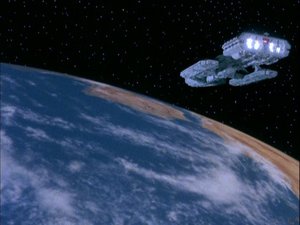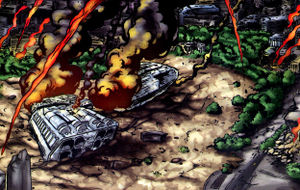For information on Earth from other series, see: Earth.
|
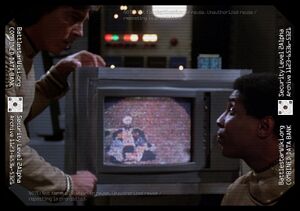
Earth is believed to be the home of the lost Thirteenth Tribe in the Original Series.
As told in the Book of the Word, the lost Thirteenth Tribe settles the planet Earth, following its exodus from Kobol from an environmental cataclysm that also caused the Exodus of the Twelve Tribes. As the Thirteenth Tribe left opposite the other Twelve Tribes, the information of their destination resided in the tomb of the Ninth Lord of Kobol, but could not be recovered before Lucifer's attack (TOS: "Lost Planet of the Gods").
Transmissions on an obsolete gamma frequency believed to be from Earth—the Apollo Moon Landing—are intercepted and recorded by Apollo in the celestial chamber. Further analysis of the recording proved impossible as the only copy of the transmission is destroyed in an attack on a Cylon basestar (TOS: "The Hand of God").
Notes[edit]
- Due to the discovery of several planets possibly inhabited by humans of the Thirteenth Tribe, especially Terra and the Eastern Alliance, it may be assumed that Earth is very advanced in terms of technology, and could be more than a match for the Cylons.
- These planets may be inhabited by humans left behind by the Thirteenth Tribe on the trek to Earth (if not migrated and forgotten members of other Colonial habitations), and as such give no real clue as to Earth's status. The transmission of the Apollo 11 landing (which, barring other non-Einsteinian means, would travel at light-speed) could be used to define the distance between the Fleet and Earth.
- The events of Galactica 1980, set 30 years after the events in "The Hand of God" and recorded as its own divergent continuity, contradict this.
For information on 1980's Earth depicted in the Dynamite Entertainment comics, see: Earth (1980 alternate).
|
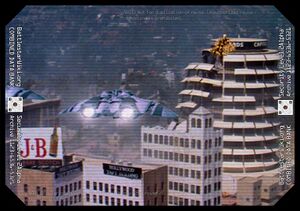
Thirty years after the Battle of Cimtar, the Fleet's quest to find the Thirteenth Colony of Earth becomes a reality.
Much to the dismay of Adama and his Galactica crew, their brother tribe on Earth was underdeveloped technologically in comparison to the destroyed worlds of the Twelve Colonies of Man and would not be able to defend themselves from any Cylon encounters. At the time of their arrival, the year is 1980 CE
Adama and Doctor Zee map out a plan to accelerate Earth technology to aid in their defense with Warriors Troy and Dillon leading expeditions to the planet (1980: "Galactica Discovers Earth, Part I").
Unfortunately, in addition to chance encounters by Cylon patrols, a rogue Quorum member, Xaviar, attempts to force Earth's technology advances with more dramatic and destructive means.
Composition[edit]
Earth's composition is very much astonishing to the Colonials. According to Adama, Earth's "proximity to the sun provides the only climate in the galaxy comfortably able to support life as we know it." Furthermore, he explains that seven-tenths of the Earth is ocean, which astonishes the council members and the Warriors present, but assures them that there's "plenty of room for all our people."
He further notes that the seven principal landmasses, two of which (Antartica and the North Pole) are polar ice caps, could be "easily reclaimed" by their technology (1980: "Galactica Discovers Earth, Part I" ).
Technology[edit]
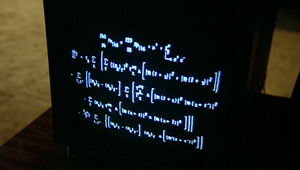
At the time of 1980, nuclear power is a major concern on Earth, particularly due to the waste it generates. One of Earth's prominent nuclear physicists, Dr. Donald Mortinson, has been working on a theory to dissolve nuclear wastes (i.e. nuclear degeneration, a theory that Colonials are taught, though most apparently understand) for three years prior to the Galacticans arrival.
As such, Troy and Dillon leave a "calling card" and correct the formula, which Mortinson recognizes as one from an intelligent extraterrestrial society (1980: "Galactica Discovers Earth, Part I").
Notes[edit]
- Most of the Earth scenes in Galactica 1980 took place in Southern California, with the main exception of the time travel sequence to Nazi Germany (which still looked a lot like Southern California) and the trip that Troy and Dillon take to New York City.
- The memorable attack simulation by the Cylons, created by Doctor Zee, focuses particularly on Hollywood, as noted with the destruction of the Capitol Records Building. These scenes were recycled from the 1974 movie Earthquake, itself starring Lorne Greene (Adama).
- There were hints in the Original Series that Earth may be technologically advanced (e.g. Terra, the Silent One's drawing on Proteus). However, perhaps due to budgetary constraints in the sequel series, Earth was ultimately revealed to be the contemporary one.
- In the Galactica Discovers Earth novelization, Zee posits that, even with Galactican assistance, it will take 8 to 9 centuries before Earth could develop technology to withstand the Cylons.[1]
See also[edit]
References[edit]
- ↑ Resnick, Michael (1981). Battlestar Galactica 5: Galactica Discovers Earth. Berkley Books, p. 142.
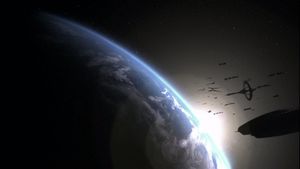
Earth is the believed destination of the Thirteenth Tribe of Kobol, as attested in the Sacred Scrolls. Prior to its discovery, its existence is considered purely mythical and legendary within Colonial and Cylon societies. Earth is also the name of a planet Colonial survivors eventually settle after a long and arduous journey across space following the Fall of the Twelve Colonies.
Earth: Home of the Thirteenth Tribe[edit]
Beginnings[edit]
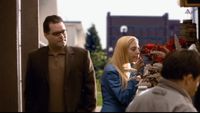
- Main articles: History of the Twelve Colonies and Thirteenth Tribe (RDM)
The legend of Earth begins at least four thousand years ago on Kobol, where Scriptures tell of the exodus of a Thirteenth Tribe of humanity during a period of great turmoil across the planet. It is said that "they traveled far and made their home upon a planet called Earth . . . which circled a distant and unknown star." While not many previously believed in Earth, there are artifacts rumored to point out the general direction to the planet. These rumors are later confirmed after the destruction of the Colonies (TRS: Miniseries, "Kobol's Last Gleaming, Part I").
Settlement and Development[edit]
For nearly two thousand years, the Thirteenth Tribe flourished on the planet, creating a civilization comparable to the Twelve Colonies before their fall, including development of their own robotics and artificial intelligence. Unbeknownst to Colonials or most Cylons, the Thirteenth Tribe was a flesh and blood race of artificial beings much like the humanoid Cylons, which were created on Kobol thousands of years ago. They originally relied on organic memory transfer technology to download into new bodies after their deaths. However, sometime after leaving Kobol, they gained the ability to reproduce sexually, and the technology fell out of use (TRS: "No Exit").
- The fact that the Tribe was artificial in nature is never fully revealed to the civilians of the fleet. To them, they were a society of humans that were destroyed by their robotic creations much like their society was four years prior.
Apocalypse[edit]
- Main article: Final Five
Approximately two thousand years BCH, the Tribe's robotic creations rebelled against their creators, in an act of mutually assured destruction. The attack caught the population off guard, with many at work or enjoying leisurely activities. Evidence of people going about their lives is still visible on the remains millennia later. However, prior to the apocalypse, five individuals started seeing visions of strange people warning them of the upcoming cataclysm. The five worked hard to recreate the lost organic memory transfer technology, and built a ship in orbit to carry their experiments. After their deaths, the five were resurrected on this ship, and opted to follow the Tribe's original course back to Kobol, leaving Earth behind (TRS: "Revelations", "Sometimes a Great Notion", "No Exit").
Earth's Fate[edit]
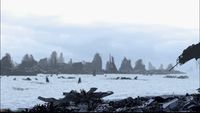
At the conclusion of the war, no survivors remained on either side, and Earth was left burning and irradiated. Despite lingering radioactive contamination, plant life gradually returned, and whatever ruins remained succumbed to nature and time. A large city on the planet visited by both Colonials and rebel Cylons was largely submerged in water and partly buried in sand.
Unable to support human life, the planet is abandoned days after its discovery, and is likely never visited again (TRS: "Kobol's Last Gleaming, Part I," "Kobol's Last Gleaming, Part II," "Revelations," "Sometimes a Great Notion").
A New Earth: The Promised Land[edit]
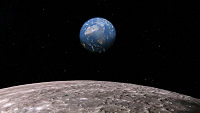
By an infinitesimal chance, a habitable planet is found by pilot Kara "Starbuck" Thrace, after she is able to extrapolate FTL jump coordinates from a song she used to play as a child. Lt. Thrace inputs these FTL coordinates into Galactica's FTL computer in a desperate attempt to escape from the Cylon Colony. Galactica, damaged from battle, limps into orbit of the planet.
- As depicted in "Crossroads, Part II," this planet is located relatively close to the Ionian Nebula.
Diverse Wildlife[edit]
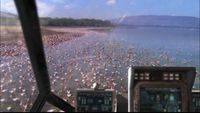
After Colonial recon of the planet, Earth is discovered to have a diverse range of wildlife, more than the Twelve Colonies put together. It also features a race of primitive hunter-gatherer humanoids, having evolved here separately from those on Kobol. Upon further study, these humanoids are discovered to be compatible with Colonial DNA, which opens up the possibility of Colonials and Cylons interbreeding with them.
Colonial/Cylon Settlement and Future Evolution[edit]
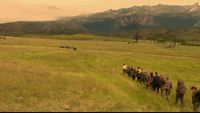
With Galactica in pieces, and the Colonial Fleet not fairing any better, it is decided that the planet will be settled, with the remaining Cylons soon joining them. Plans begin for new cities to be built, but those plans are soon abandoned in favor of starting fresh in an attempt to break the historical cycle of violence. Colonial units scout the planet, and eventually determine the best possible chance for survival is to split the survivors into groups, and spread them across different sites around the globe. These locations are documented, and presented to each of the groups for future use. After the survivors set up their camps, the fleet and any remaining advanced technology are scuttled. The settlers christen this new planet "Earth," in honor of the promised land they have been chasing for four years.
The surviving Colonial and Cylon settlers and their descendants begin interbreeding with the indigenous humanoids, creating a new race, with the first human-Cylon hybrid becoming "Mitochondrial Eve," the most recent common matrilineal ancestor of all living humans. Her fossilized remains are uncovered nearly one hundred fifty thousand years later, around the time that another advanced human society is on the brink of major breakthroughs in robotics - much like the Twelve Colonies, the first Earth, and Kobol before them (TRS: "Daybreak, Part II").
Notes[edit]
- Gaeta comments in "Revelations" that the constellations seen from orbit of the Earth they had just found match those seen in the Tomb of Athena. This was later proven incorrect, as those constellations are actually visible from a different Earth over one hundred centuries later (TRS: "Daybreak, Part II"). It would have been extremely improbable that the constellations visible from the Earth found in "Revelations" would have looked the same as those of New Earth. That being said, while on the first Earth, all of the constellations of Zodiac could all be seen at once-this is not possible on the current Earth.
- From what is known of the nature of navigation in FTL jumps, the odds of the coordinates used by Kara Thrace to jump Galactica from the Colony to the new Earth and actually achieving the end they did are no less than infinitesimal. One of the elements in FTL navigation is the point of origin. A point of origin is a necessary factor in many navigational forms in order to plot direction and distance to a required destination, and FTL navigation is no different. Essentially, what this means is that the coordinates entered by Kara Thrace into the FTL computer aboard Galactica would only jump the ship to its new Earth destination from the precise astral location of Galactica when it initiated the jump from the Colony. Given the coordinates' origins in the Music and the revelation that a divine entity is in some way shaping the events which have taken place in the series, as seen by Pythia, it could be suggested that the attack on the Colony and the resulting success and retreat were in some way destined. While this may seem logical, it is purely conjectural. The way these events have took place cannot be explained by rational means.
Official Statements[edit]
- Edward James Olmos jokingly describes how he thinks the Fleet could find Earth:
- I personally — this is not [from] any of the writers, but my thing — I wanted to come into [the present day], find Earth, cruise on top of it, see it for what it is, and as we're coming down to it, we're blown up, we're nuked. And then [someone says to] the President of the United States, which is [George W.] Bush, "They've been taken care of. Thank God you saved the world again." And you turn, and you see who told him that, and it's one of the Cylons. [Laughs][1]
References[edit]
- ↑ Vary, Adam B. (23 March 2007). Four-ward, Cylons: Edward James Olmos (backup available on Archive.org) (in ). Retrieved on 22 June 2007.
